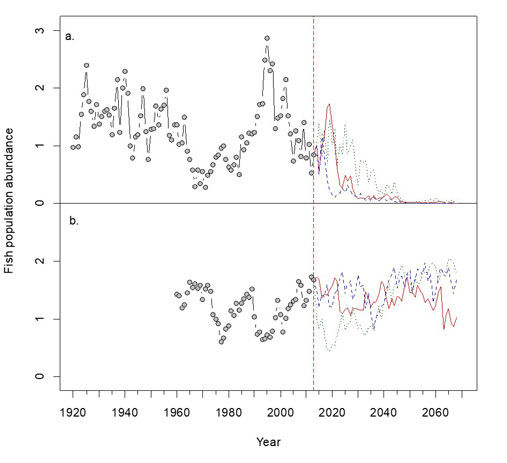In marine biology and fish biology in particular a lot of attention is put on how the fish populations are renewing themselves (see post). Since the start of the 20th century, a lot of research effort have been put on understanding the importance of reproduction for fish populations and how the young fish are becoming big enough to be harvested: recruited to fisheries.
Among all the different hypotheses developed to help understanding the population change, the match-mismatch hypothesis is explaining the survival of the young fish by the synchrony with the seasonal productivity of its prey. This hypothesis was developed in the 1960s by the English fisheries biologist David Cushing (see post). Cushing demonstrated that for small marine fish living in seasonal environments, where the prey have peak of production, an asynchrony with this peak leads to a lack of food for the fish and an unsuccessful reproduction and recruitment.
Knowing that the temperature is affecting the timing of reproduction in many organisms, we have explored how climate warming would affect the recruitment of fish that have their reproduction tightly linked to their prey by a match-mismatch relationship. We have focussed our study on small marine fish that are both an important harvested resource and a crucial link between the plankton they feed on and their own predators.
We have developed a model simulating how fish abundance changes for an high latitude (Polar fish) fish population, in the Barents Sea, and for a temperate fish population, in the Bay of Biscay, both feeding on zooplankton (recently reported in Durant et al. 2019). The IPCC is reporting the possible temperature increase for the next 100 years (or climate-warming projections). Using one of these temperature projections, we have developed a mathematical model to project the change of the fish population abundance over the next 50 years.
While the timing of the temperate fish reproduction is following the change of the timing of the zooplankton, the high latitude fish is stopping to be in synchrony with the plankton. Following our model, the high latitude fish will be to be more often in a mismatch situation with its prey. Such mismatch situations leading to frequent reproduction failure, we thus expect that with climate warming the high latitude fish population will decline and even can collapse in a 50-year time range.

Of course, this is not a prediction, meaning that many other factors may prevent this fatal outcome: change of prey, migration, change of spawning period… As it should be, nothing is more difficult to make predictions on than the future. However, our models tell us that the high latitude species seem less robust to changes in seasonality due to climate change than temperate species. The change in the timing of the zooplankton peak due to climate warming is more likely to cause a collapse of high latitude fish… apart if they adapt to new conditions.
Reference:
Durant JM, Molinero J-C, Ottersen G, Reygondeau G, Stige LC, Langangen Ø (2019) Contrasting effects of rising temperatures on trophic interactions in marine ecosystems. Scientific Reports 9:15213

Log in to comment
Not UiO or Feide account?
Create a WebID account to comment